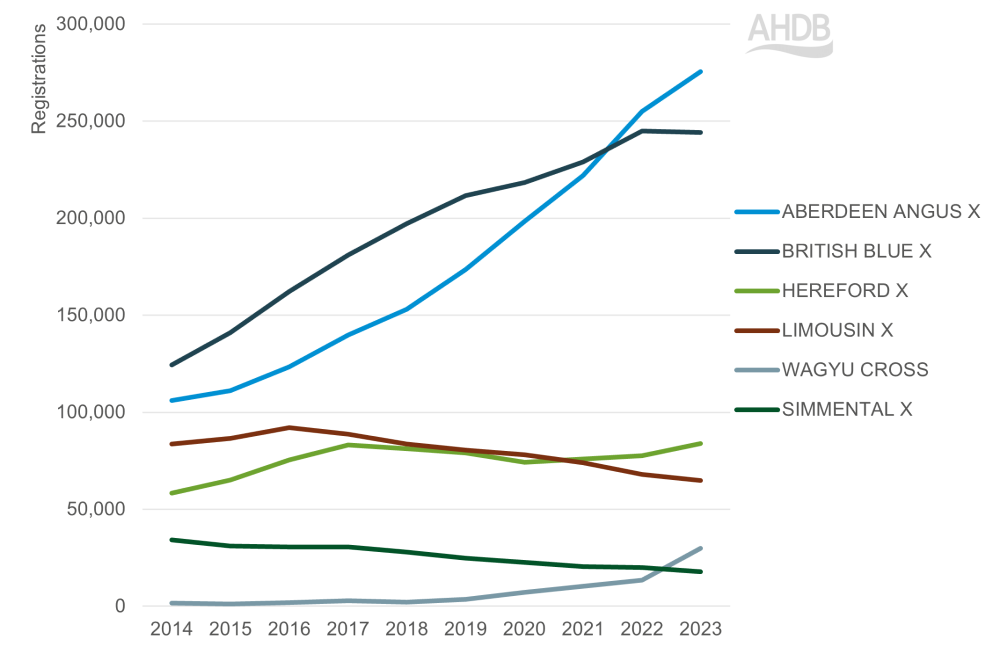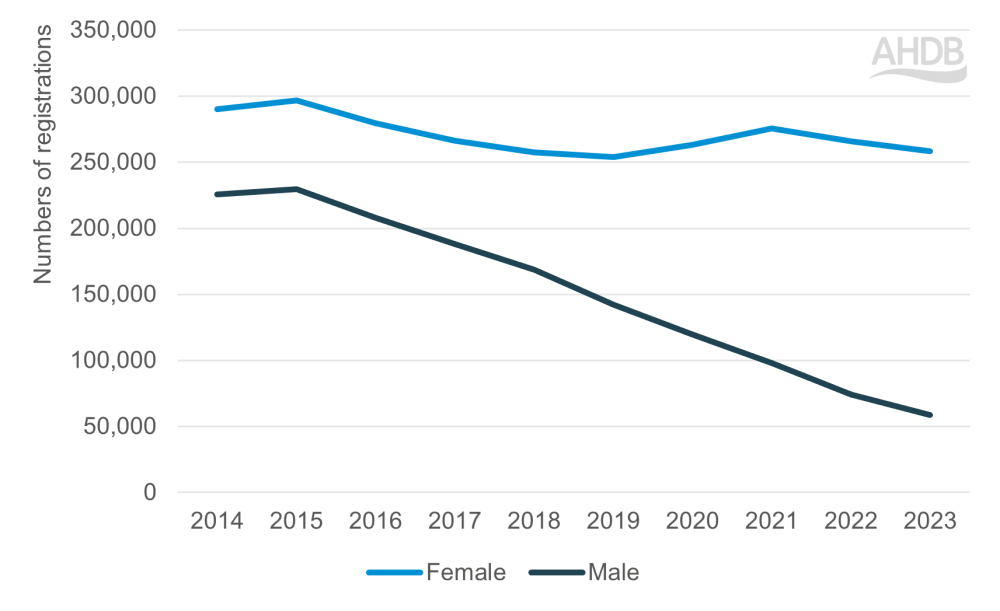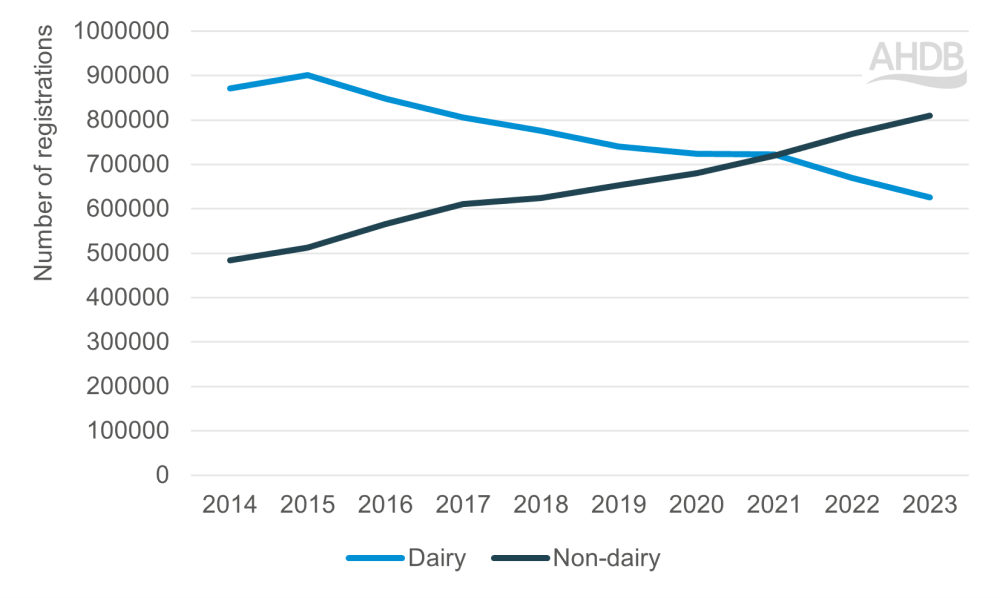Long-term trends in breeding choices on the dairy farm
Thursday, 16 May 2024
Over the last ten years, we have seen changes in the output of the dairy herd, with industry strategies moving to reduce dairy bull calves and a significant increase in dairy beef. BCMS data allows us to see the impact of these initiatives in calf registration numbers.
Steady decline in Holstein registrations
Holstein Friesian (HF) has consistently been the most popular calf breed on the dairy farm since 2014. However, the number and share of calves born to dairy dams that are registered HF has been steadily reducing over the same period. In 2014, 516,000 HF calves were registered to dairy dams, making up 38% of the total calves registered to dairy in that year. By 2023, that number had reduced to 317,000 HF calves, representing 22% of the output of the dairy dams in that year. Digging into these numbers, it is not surprising to see that this change was primarily driven by a large reduction in the number of bull HF calves registered. In 2023, 59,000 bull HF calves were registered, an almost fourfold decrease from the 225,500 in 2014.
Registrations of HF heifers have also declined in the last ten years, albeit in a much steadier manner. They have declined from a peak of 297,000 in 2015 to 258,000 in 2023. This follows the trend of gradual, long-term decline in the population of the milking herd, due to improvements in productivity, meaning that fewer replacement heifers are required to come into the dairy herd to maintain milk yields, alongside some reduction in herd numbers as producers have exited the industry.
Holstein Friesian calves registered to dairy dams over time
Source: BCMS
Fluctuation in other dairy calf breeds
Holstein calves have maintained a fairly stable share, making up around 6% of the total calves registered from dairy dams each year in the past ten years.
On the other hand, British Friesian calves have seen a decline in numbers. Just under 100,000 calves were registered in 2014, equal to 7% of total dairy registrations in that year. By 2023, this had dropped to 58,500, with a share of 4%. Again, this can be mainly attributed to significant declines in the number of bull calves, with heifer calves showing a smaller yet steady reduction in numbers over the period.
Increasing number of dairy-beef calves
The BCMS data clearly reflects the increased use of beef sires in the dairy herd. In 2023, 56% of calves registered to dairy dams were beef-bred calves, compared to 36% in 2014. This reflects the industry trend, as we have seen an increasing number of dairy producers using beef sires on their lower genetic merit cows.
Number of registrations by calf type
Source: BCMS
Changing beef breed choices for dairy cows
Aberdeen Angus X (AAX) and British Blue X (BBX) calves are the two most popular beef breeds chosen for dairy crossing, and both have seen significant growth in numbers over the last decade. The first year in which we saw a greater number of AAX calves registered to dairy dams than BBX calves was 2022, with AAX calves making up 19% of the calves registered from dairy cows in 2023. This growth has likely been supported by the introduction of integrated beef supply chains.
Delving into other beef breeds, we have seen a surge in the number of Wagyu calves registered out of the dairy herd. From 2022 to 2023, registrations of Wagyu calves out of the dairy herd more than doubled to a total of 30,000 heads in 2023. A similar story is evident for Longhorn X, with dairy-born registrations totalling 7,000 heads in 2023, an 81% increase on the previous year. This growth might also be attributed to the supply chain schemes that offer a premium for cattle of these breeds.
On the other hand, registrations for Simmental X and Limousin X cattle out of the dairy herd have steadily declined over the last ten years. In 2014, we saw 84,000 and 34,000 registrations to dairy dams for Limousin X and Simmental X calves, respectively, compared to 65,000 and 18,000 for the same breeding in 2023. This reflects a movement away from the continental breed sires on the dairy farm.
Beef calf registrations to dairy dams over time, by popular breeds

Source: BCMS
*Top six breeds, by number of registrations in 2023
Conclusions
The BCMS registrations data clearly demonstrates the changing output of calves from the dairy herd over the past decade. We see a significant reduction in dairy bull calves, against a steadier decline in dairy heifers that reflects trends seen in the milking herd. The data also highlights the growing numbers of dairy-beef calves, particularly in the native breeds, and the movement away from breeding dairy cows to continental beef sires.

Sign up to receive the latest information from AHDB.
While AHDB seeks to ensure that the information contained on this webpage is accurate at the time of publication, no warranty is given in respect of the information and data provided. You are responsible for how you use the information. To the maximum extent permitted by law, AHDB accepts no liability for loss, damage or injury howsoever caused or suffered (including that caused by negligence) directly or indirectly in relation to the information or data provided in this publication.
All intellectual property rights in the information and data on this webpage belong to or are licensed by AHDB. You are authorised to use such information for your internal business purposes only and you must not provide this information to any other third parties, including further publication of the information, or for commercial gain in any way whatsoever without the prior written permission of AHDB for each third party disclosure, publication or commercial arrangement. For more information, please see our Terms of Use and Privacy Notice or contact the Director of Corporate Affairs at info@ahdb.org.uk © Agriculture and Horticulture Development Board. All rights reserved.



